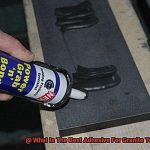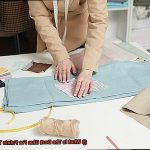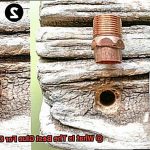When they involve dropping a beloved ceramic heirloom or your go-to porcelain mug, it can feel like your heart skips a beat. But fear not. With the right adhesive in hand, you can restore your broken ceramic to its former beauty. In this blog post, we’ll dive into the captivating world of adhesive solutions and help you find the best glue for repairing your cherished ceramics.
Not all glues are created equal when it comes to bonding ceramic pieces. Strength, durability, and aesthetics all play a crucial role in achieving a flawless repair. As someone who loves both glues and ceramics (yes, that’s a thing.), I’ve put various adhesives to the test to find the perfect match.
So come along on this adhesive adventure as we explore the top contenders in ceramic repairs. From traditional epoxies to specialized ceramic glues, we’ll uncover their secrets, share expert tips, and ultimately reveal the ideal glue for your broken ceramics.
Whether you’re an avid pottery enthusiast, prone to clumsiness, or simply seeking a DIY solution, this blog post will equip you with the knowledge and confidence needed for your own ceramic repairs. So fasten your seatbelts and get ready for an unforgettable journey filled with unbreakable bonds and the resurrection of cherished ceramic treasures.
Types of Ceramic
Contents
Ceramics, a captivating art form that has mesmerized humanity for centuries, encompasses a diverse range of materials. From delicate porcelain that exudes elegance to the rustic allure of terra cotta, each type of ceramic possesses distinct properties and characteristics. In this article, we embark on an enchanting journey through five different types of ceramics, delving into their remarkable features and discussing the best glues for repairing these cherished items.
Porcelain:
Porcelain, renowned for its strength, durability, and ethereal translucency, stands as a testament to the magnificence of ceramics. With its smooth and glass-like finish, porcelain finds its place in exquisite decorative pieces and luxurious tableware. When restoring broken porcelain treasures, selecting an adhesive that can withstand high temperatures while securely bonding to its sleek surface is essential. Only then can we revive these intricate works of art to their former glory.
Earthenware:
Earthenware, a time-honored ceramic type dating back millennia, enchants with its porous nature and rustic charm. This versatile material finds its purpose in pottery, garden pots, and ornamental creations. Repairing earthenware necessitates an adhesive capable of penetrating its pores to forge a resilient bond. Only with such meticulous attention can we mend these fragments and breathe new life into their ancient stories.
Stoneware:
Stoneware stands as a testament to the enduring strength and durability of ceramics. Crafted through high-temperature firing, this dense material exhibits an earthy aesthetic cherished in kitchenware, dinnerware, and baking dishes. Preserving the integrity of stoneware during repairs calls for an adhesive that adheres effectively without compromising its food-safe properties. With the right choice of glue, these culinary companions can continue serving up delectable delights for years to come.
Bone China:
Bone china, a luxurious variant of porcelain enriched with bone ash, captivates with its delicate appearance, exceptional strength, and captivating translucency. Adorning fine china dinnerware sets, this peerless ceramic demands a bond that seamlessly melds with its smooth surface while preserving its delicate allure. Only by selecting the perfect glue can we restore these treasures to their rightful place at the heart of elegant dining experiences.
Terra Cotta:
Terra cotta, with its warm reddish-brown hue, embodies the essence of earthenware. Fired at low temperatures, this porous material finds its purpose in pottery, flower pots, and architectural elements. Repairing terra cotta necessitates an adhesive capable of penetrating its surface and forging a robust connection. With the right adhesive in hand, we can mend these humble yet captivating creations and honor their timeless beauty.
Strength of the Bond Required
When it comes to repairing broken ceramics, the strength of the bond required depends on the specific application of the item. Here are some factors to consider when choosing the right glue:
- Assess the application: Is it a delicate figurine or a decorative piece that won’t endure much stress? In this case, a less strong adhesive like a basic craft glue or a multipurpose adhesive might suffice. These glues provide a decent bond for lighter ceramics and are easy to work with.
- Functional ceramics: If you’re repairing a plate, mug, or vase that will see regular use, it’s time to step up your adhesive game. These items are exposed to water, heat, and friction, so you need a glue with a stronger bond. Enter epoxy glues – the superheroes of ceramic repairs. They consist of two parts – resin and hardener – that create a powerful and durable bond once mixed together. Epoxy glues can withstand various stresses and ensure your repaired piece stands the test of time.
- Consider weight and pressure: Another option for achieving a strong bond is using cyanoacrylate glue, also known as super glue. This adhesive forms an instant bond and is renowned for its high strength. It works well on ceramics but may not be suitable for larger or heavier objects as it can become brittle over time. So make sure to consider the weight and pressure your repaired ceramic will face.
- Balance strength and flexibility: While strength is crucial, it’s not the only factor to consider. Flexibility and resistance to temperature changes are also important. Some adhesives offer exceptional strength but lack flexibility, making them prone to cracking under certain conditions. So look for glues that strike the right balance between strength and flexibility.
Glue Application Method and Drying Time
Ceramics possess an undeniable charm, but mishaps can shatter their beauty. Fear not. With the correct glue application method and a touch of patience during drying time, you can resurrect your beloved pottery. This blog post delves into the significance of proper glue application and drying time, equipping you with the knowledge needed to become a ceramic repair virtuoso.
Choosing the Perfect Glue:
- Epoxy or cyanoacrylate (super glue) are the recommended glues for ceramic repairs due to their robust bonding properties and moisture resistance.
- Liquid, gel, or putty forms of glue can be considered based on the requirements of the repair.

Preparing the Surface:
- Rid the broken edges of dirt and residue that could impede bonding.
- Gently sanding the edges creates a rougher surface, enhancing adhesion.
Mastering Glue Application:
- Employ a small brush, toothpick, or applicator provided with the glue to apply a thin layer on both surfaces.
- This ensures uniform distribution and minimizes excess glue that might squeeze out under pressure.
Aligning and Applying Pressure:
- Meticulously align the broken pieces and firmly press them together.
- Maintain this position for the duration specified on the glue packaging.
- Adequate time allows for effective bonding of the adhesive.
Unveiling the Secrets of Drying Time:
- Super glue dries rapidly within minutes but requires several hours or days to fully cure.
- Epoxy glues have longer drying times, usually necessitating 24 hours for complete curing and maximum strength.
Reinforcing Support:
- Additional support may be necessary during drying.
- Utilize clamps, rubber bands, or tape to hold the pieces together, exerting gentle and even pressure without inflicting further damage.
Epoxy Adhesive
Brace yourself, because we’re about to unlock the secrets of ceramic repair wizardry with the mighty epoxy adhesive. Prepare to be captivated by the enchanting world of glue.
The Perfect Glue:
Epoxy adhesive reigns supreme in the realm of ceramic repairs, boasting a bond of unparalleled strength and durability. This magical elixir consists of two components – resin and hardener – that must be skillfully mixed before application.
Surface Preparation Mastery:
To ensure a triumphant repair, prepare the surfaces like a seasoned pro. Cleanliness is paramount – banish all traces of dirt and debris and ensure a dry canvas awaits the adhesive’s touch. Remember, attention to detail sets the stage for success.
Unleashing Glue Application Techniques:
Epoxy adhesive possesses the power to fill in gaps and create imperceptible bonds, making it ideal for resurrecting shattered ceramics. Apply the adhesive with precision, ensuring even distribution. Beware the curse of excess glue, which can mar the beauty of your restoration.
Aligning and Embracing Pressure:
Before the magic begins, align those fragmented pieces with unwavering accuracy. Embrace clamps or other mystical means to apply gentle pressure, holding them steadfast during the curing process.
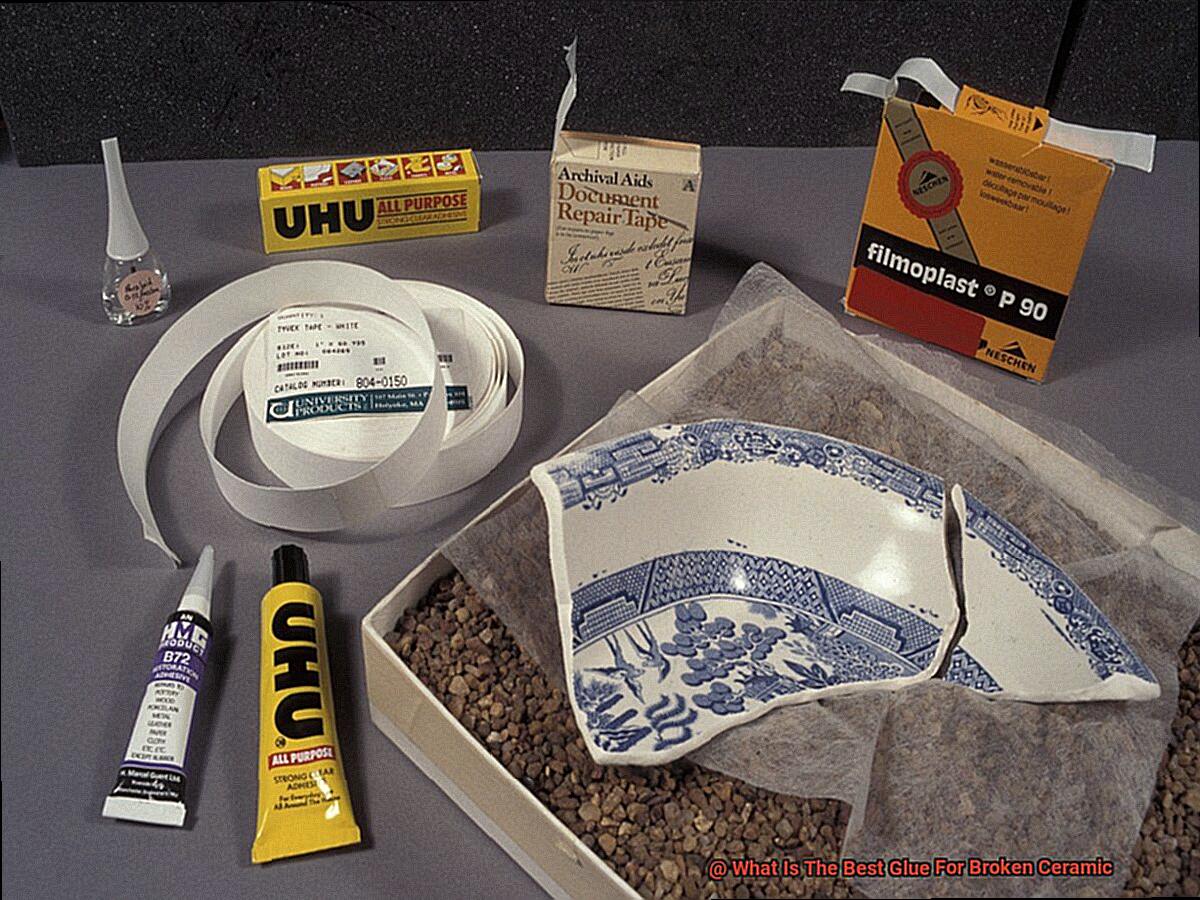
Unraveling Drying Time Mysteries:
Patience is an invaluable virtue when dealing with epoxy adhesives. Allow ample time for the potion to work its wonders, reaching its zenith of strength. Only then shall your restored ceramic withstand life’s trials and tribulations.
Reinforcing Support for Flawless Restoration:
Some ceramics may require reinforcements during their resurrection. Seek counsel from experts or sages who possess wisdom in the ways of epoxy adhesive, ensuring the perfect match for your ceramic treasure.
Cyanoacrylate Adhesive (Super Glue)
Cyanoacrylate adhesive, commonly known as Super Glue, is a remarkable adhesive that can bring shattered ceramics back to life. This adhesive is like a superhero in the world of repairs, with its super-fast drying time and unbeatable strength.
One of the key advantages of Super Glue is its incredible speed. Unlike other adhesives that can take hours to dry, Super Glue sets in mere seconds. This means you can fix your broken ceramic pieces quickly and efficiently without having to wait around. It’s perfect for delicate or intricate ceramic items where you want to minimize further damage during the bonding process.
Not only is Super Glue fast, but it’s also incredibly strong. Once it cures, it forms a bond that can withstand everyday use and handling. Whether you’re fixing a decorative ceramic item or your favorite dinnerware, Super Glue will keep everything securely in place.
Before you embark on your ceramic repair journey, there are a few considerations to keep in mind. Firstly, make sure the broken edges of your ceramic piece are clean and free from any debris or residue. Super Glue bonds best to clean surfaces, so it’s a good idea to gently sand or clean the area before applying the adhesive.
When applying Super Glue, ensure an even layer is applied on both surfaces that need to be bonded. Press them together firmly and hold them in place for a few seconds to allow the glue to set. Your broken ceramic will now be as good as new.
However, it’s important to note that Super Glue may not be suitable for all types of ceramics. Porous or highly textured ceramics may not provide enough surface area for the glue to adhere properly. In these cases, it’s best to seek out alternative adhesives specifically designed for porous materials.

Silicone-Based Sealants
Greetings, fellow DIY enthusiasts. Are you tired of seeing your beloved ceramic treasures gathering dust in pieces? Fear not, for today we delve into the world of silicone-based sealants and discover why they are the perfect sidekick for repairing those broken ceramic gems.
Let’s start with the jaw-dropping bonding strength of silicone-based sealants. Formulated with silicone polymers, these bad boys boast some serious adhesive power. Their bond is so mighty that even Superman would be impressed. Say farewell to unsightly cracks and welcome a repair job that’s as solid as a rock.
But wait, there’s more. What sets silicone-based sealants apart from other glues is their flexibility. While some glues harden into rigid states, these sealants remain flexible even after curing. Picture your repaired ceramics donning a suit of armor capable of withstanding movement and stress without cracking or breaking again. It’s like granting your ceramics superpowers to conquer any challenge life throws their way.
Now, let’s talk about the superhero-like resistance to moisture that silicone-based sealants possess. We all know ceramics and liquids go hand in hand (or should I say hand in mug?). Whether it’s your cherished coffee mug or an exquisite vase, you’ll want your repaired ceramic to remain watertight. Enter silicone-based sealants. They are resistant to moisture, ensuring that your repaired ceramic can handle accidental spills or even trips through the dishwasher without missing a beat.
And let’s not forget about their superpower of temperature resistance. Imagine this: you have a delightful teapot with a broken handle. You want to repair it so you can enjoy a piping hot cup of tea worry-free. Well, fear not, for silicone-based sealants have got your back (or rather, your handle). They can withstand scorching temperatures without losing their adhesive properties or degrading. So go ahead, pour that boiling water into your repaired teapot – it can handle the heat.
Before embarking on your ceramic repair mission, keep a few things in mind. Opt for a high-quality silicone sealant specifically designed for bonding ceramics. Read the label and follow the manufacturer’s instructions for application and curing. And, of course, don’t forget to thoroughly clean those broken edges before applying the sealant – cleanliness is key to a successful repair.
Manufacturer’s Instructions
Fear not. With the right adhesive and a little know-how, you can resurrect your beloved ceramics. However, it is crucial to follow the manufacturer’s instructions for a successful repair. In this comprehensive guide, we will explore the importance of these instructions and how they can make all the difference in your ceramic repair journey.
The Power of Bonding:
Not all adhesives are created equal when it comes to gluing ceramics. Each brand has its own unique formula and properties. By adhering to the manufacturer’s instructions, you ensure a secure bond that withstands the test of time. Say goodbye to weak bonds that lead to disappointment or further damage.
Prepping for Success:
Before diving into the repair process, take a moment to carefully read those instructions. Most ceramic adhesives require clean, dry surfaces free from dust and grease. The manufacturer’s instructions will guide you on necessary preparation steps, such as using gentle cleaners or alcohol to remove dirt and residue. Trust me, this step is essential for a rock-solid bond.
Technique Matters:
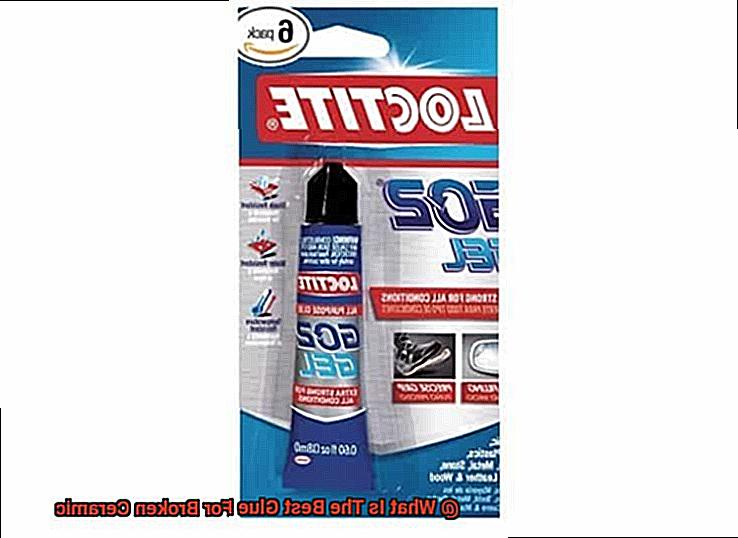
Choosing the right adhesive is only half the battle; applying it correctly is equally important. Manufacturer’s instructions often outline the recommended application method for their specific product. Some glues may require both surfaces to be coated, while others may call for one surface to be coated and pressed firmly against the other. Following these guidelines ensures proper adhesion and a seamless repair.
Timing is Everything:
Patience plays a vital role in repairing ceramics. The manufacturer’s instructions specify the curing time needed for the adhesive to fully set. This duration may vary depending on the glue brand and type used. Rushing this step could compromise the bond, resulting in a less durable repair. So give the glue the time it needs before subjecting your cherished ceramic piece to stress or pressure.
M2vtfNxHVv0″ >
Also Read: How To Glue Ceramic Back Together?
Conclusion
In conclusion, finding the perfect glue to mend your shattered ceramics is crucial in restoring their former magnificence. Each type of ceramic necessitates a specific adhesive that complements its unique properties and characteristics.
For porcelain, a resilient adhesive capable of enduring high temperatures is indispensable to preserve its elegance and translucency. Earthenware calls for an adhesive that can penetrate its porous surface, creating an unyielding bond. Stoneware, renowned for its durability, requires a glue that adheres effectively without compromising its food-safe properties. Delicate bone china demands a bond that flawlessly melds with its smooth surface while preserving its allure. The warm-hued terra cotta necessitates an adhesive capable of penetrating its surface and forging a robust connection.
When selecting the ideal glue, take into account the strength required for the specific application of the item. Whether it’s a fragile figurine or functional ceramics like plates or mugs subjected to regular use, choose accordingly.
Proper glue application and drying time are paramount for successful ceramic repairs. Thoroughly cleanse the broken edges before applying the adhesive and ensure even distribution on both surfaces. Precisely align the fractured pieces and apply pressure during curing to achieve an unwavering bond.
Epoxy glues come highly recommended for their exceptional strength and durability, while cyanoacrylate glues (super glue) offer rapid drying times coupled with remarkable strength. Silicone-based sealants provide flexibility along with resistance to moisture and temperature fluctuations.
Lastly, always adhere to the manufacturer’s instructions for each specific adhesive to guarantee a secure bond that endures time and stress.


